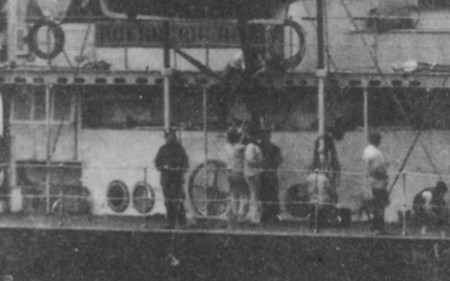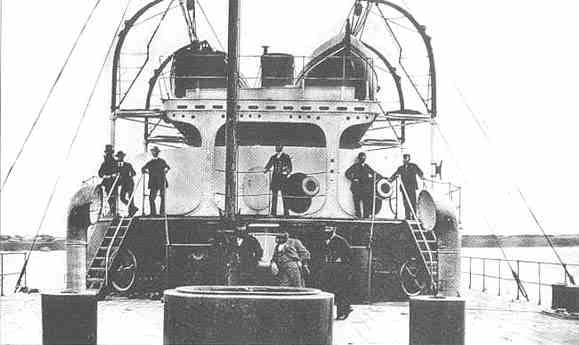Finally finished.
As I mentioned before there were only minor things left to do. The blocks and tackles were the same as on the boat’s davits. I photo etched the frames, mended them to the hooks and eyes and glued a little roll from 1 mm ABS in them. The „rope“ was drawn through rings on the deck and belayed on the small bollards.

The supporting bands for the lifeboats were made from thin cigarette paper I spraypainted white. The bands get little buckles on their ends with a hook on them to clasp in rings glued to the davits upper ends.

Meanwhile Rick Freyer called my attention on an article on
http://www.cerberus.com.au/ wth these mysterious wheels as topic:

We talked about them before and couldn’t find any explenation for them, now they were described as wheels to close the watertight doors in case of leaking. These were later in the 80s moved to the inside of the ship. This lead me to the conclusion that these wheels

were also for closing these doors as there were also some of them on the main deck. This would also solve the riddle of the moving pumps. On
http://www.cerberus.com.au it is said that the wheels under the ladderways were the original pump wheels that later moved before the toilets. I really doubted that from the start because no one could efficiently handle a pump wheel under a ladder way where there is hardly room for one person. Also there was no written evidence that the pumps where moved in the later years. So the solution is: Thepumps never moved, they were just removeable. There is no photograph of both sort of wheels because on the early pictures the ship is in dock so there was no need to build up the pumps while the pictures showing them where taken at a time when the closing wheels moved to the inside of the ship (@ Bill Addley: That’s one of the points why I doubt that a question to people working at the cerberus webside would help to solve the nameplate-problem. They do a really great work to save the world’s last existing turret-ship and collecting all sorts of pictures, articles and documents but their technical guesses seem to be questionable at least. On the other hand their forum has been taken down so there is also no mor place to discuss questions.)
As my model depicts the Cerberus in her early years I etched the pump wheels sticked them on little brass spindles and glued them in place.

Last thing to put in place was the flag. I printed them out on thin papers (front and backside) and glued them together. But I must say I am not quite satisfied with it. To begin with the flag is just wrong because it is the modern flag of Victoria. The ship in the 1870s would have flown a flag without a crown above the stars. Secondly the both sides just don’t stick nicely together as the glue unsolders again and again. But next week we get a new colour laser printer in office that can print double sided. Maybe I give it a try.

So after seven months of working my HMVS Cerberus is finally finished and I can concentrate on the Masséna. I still think it is a nice ship and an important step in shipbuilding. After all she is the first real warship planned and built to work without sails (save the „delivery-sails“ that were not part of the original plan) and the first with the configuration that was later the standard for the Pre-Dreadnaughts of all nations (not the famed HMS Devastation). As a model I think it is quite a good project for the first steps in scratchbuilding as it has a very simple hull, a manageable superstructure and not to much but nice details. Plus the easy reserch (because there is plenty of material on the Cerberus webside) it makes a nice start for advanced beginners and a funny „in-between-model“ for the experienced modeller who is not so fancy starting a new big project.
Some impressions of the finished ship:







Cheers
Dirk



